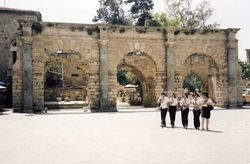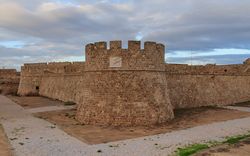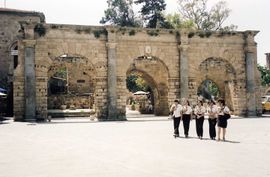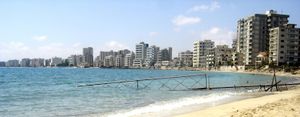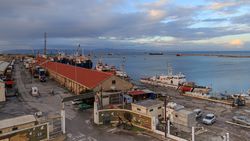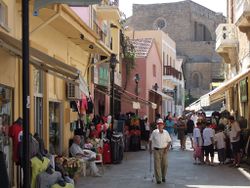فاماجوستا
فاماگوستا
Famagusta | |
|---|---|
 | |
| الإحداثيات: 35°07′30″N 33°56′30″E / 35.12500°N 33.94167°E | |
| البلد | شرعياً أمر واقع: |
| المنطقة | شرعياً: منطقة فاماگوستا أمر واقع: منطقة غازيماغوسا |
| Country (de facto) | |
| • District | Gazimağusa District |
| الحكومة | |
| • العمدة | سليمان أولوتشاي |
| التعداد (2019) | |
| • Municipality | 55٬648[2](District:91٬307)[3] |
| منطقة التوقيت | UTC+2 (EET) |
| • الصيف (التوقيت الصيفي) | UTC+3 (EEST) |
| الموقع الإلكتروني | Famagusta Turkish municipality (in Famagusta) Greek Cypriot municipality (in exile) |
فاماگوستا ( Famagusta ؛ UK /ˌfæməˈɡʊstə,_ˌfɑːmʔ/ FA(H)M-ə-GUUST-ə, الأمريكي /ˌfɑːməˈɡuːstə/ FAH-mə-GOO-stə ؛ باليونانية: Αμμόχωστος، IPA: [aˈmːoxostos]; تركية: Mağusa [maˈusa] أو Gazimağusa [ɡaːzimaˈusa])، هي مدينة على الساحل الشرقي لجزيرة قبرص وعاصمة منطقة فاماگوستا. وتطل المدينة على ساحل البحر المتوسط. It is located east of Nicosia and possesses the deepest harbour of the island. وفي العصور الوسطى (خصوصاً تحت الجمهوريات البحرية جنوة و البندقية)، Famagusta was the island's most important port city and a gateway to trade with the ports of the Levant, from where the Silk Road merchants carried their goods to Western Europe. The old walled city and parts of the modern city are a de jure territory of Republic of Cyprus, currently under the de facto control of Northern Cyprus كعاصمة Gazimağusa District.
الاسم
في القِدم، كانت البلدة تُعرف بإسم أرسينوي[4] (باليونانية قديمة: Ἀρσινόη)، على اسم الملكة الهلينية أرسينوي الثانية من مصر، وقد ذكرها بذاك الاسم اسطرابون. وفي كتاب القرن الثالث Stadiasmus Maris Magni, is written as Ammochostos (Αμμόχωστος),[5] meaning "hidden in [the] sand", which is how Greeks still call it. This name developed into Famagusta (originally Famagouste in French and Famagosta in Italian), used in Western European languages, and to its Turkish name, Mağusa. بالتركية، the city is also called Gazimağusa؛ غازي بالتركية ومنحدرة من العربية)، وقد حصلت المدينة رسمياً على اللقب بعد 1974 (قارن بـ Gaziantep). The old town is nicknamed "the city of 365 churches" owing to a legend that at its peak, Famagusta boasted one church for each day of the year.
التاريخ
تأسست المدينة حوالي سنة 274 ق.م.، بعد أن ألحق زلزال عطباً كبيراً بميناء سلاميس، في عهد پطليموس الثاني فيلادلفوس وسُميت "أرسينوي" على اسم شقيقته.[6] وصف اسطرابون أرسينوي بأنها "بلدة صيادين" في كتابه Geographica in the first century BC. It remained a small fishing village for a long time.[7] Later, as a result of the gradual evacuation of سلاميس بسبب الغزو العربي بقيادة معاوية بن أبي سفيان، تطورت لتصبح ميناءً صغيراً.
فاماگوستا القروسطية
The turning point for Famagusta was 1192 with the onset of Lusignan rule. It was during this period that Famagusta developed as a fully-fledged town. It increased in importance to the Eastern Mediterranean due to its natural harbour and the walls that protected its inner town. Its population began to increase. This development accelerated in the 13th century as the town became a centre of commerce for both the East and West. An influx of Christian refugees fleeing the downfall of Acre (1291) in Palestine transformed it from a tiny village into one of the richest cities in Christendom.
في 1372 استولت جنوة على الميناء، وفي 1489 استولت عليه البندقية. This commercial activity turned Famagusta into a place where merchants and ship owners led lives of luxury. The belief that people's wealth could be measured by the churches they built inspired these merchants to have churches built in varying styles. These churches, which still exist, were the reason Famagusta came to be known as "the district of churches". The development of the town focused on the social lives of the wealthy people and was centred upon the Lusignan palace, the Cathedral, the Square and the harbour.
Territories, colonies and trade routes of the جمهورية جنوة
Territories, colonies and trade routes of the جمهورية البندقية
فاماگوستا العثمانية
In 1570–1571, Famagusta was the last stronghold in Venetian Cyprus to hold out against the Turks under Mustafa Pasha. It resisted a siege of thirteen months and a terrible bombardment, until at last the garrison surrendered. The Ottoman forces had lost 50,000 men, including Mustafa Pasha's son. Although the surrender terms had stipulated that the Venetian forces be allowed to return home, the Venetian commander, Marco Antonio Bragadin, was flayed alive, his lieutenant Tiepolo was hanged, and many other Christians were killed.[8]

الاقتصاد
فاماغوستا هي مركز تجاري مهم لشمال قبرص. الأنشطة الاقتصادية الرئيسية في المدينة هي السياحة والتعليم والبناء والإنتاج الصناعي. لديها ميناء حر مساحته 115 فدان، وهو أهم ميناء بحري في شمال قبرص للسفر والتجارة.[9][10] The port is an important source of income and employment for the city, though its volume of trade is restricted by the embargo against Northern Cyprus. Its historical sites, including the walled city, Salamis, the Othello Castle and the St Barnabas Church, as well as the sandy beaches surrounding it make it a tourist attraction; efforts are also underway to make the city more attractive for international congresses. The Eastern Mediterranean University is also an important employer and supplies significant income and activity, as well as opportunities for the construction sector. The university also raises a qualified workforce that stimulates the city's industry and makes communications industry viable. The city has two industrial zones: the Large Industrial Zone and the Little Industrial Zone. The city is also home to a fishing port, but inadequate infrastructure of the port restricts the growth of this sector.[9] The industry in the city has traditionally been concentrated on processing agricultural products.[11]
الثقافة
The walled city of Famagusta contains many unique buildings. Famagusta has a walled city popular with tourists.[12] Every year, the International Famagusta Art and Culture Festival is organized in Famagusta. Concerts, dance shows and theater plays take place during the festival.[13]
A growth in tourism and the city's university have fueled[14] the development of Famagusta's vibrant[15] nightlife. Nightlife in the city is especially active on Wednesday, Friday and Saturday nights and in the hotter months of the year, starting from April. Larger hotels in the city have casinos that cater to their customers.[16] Salamis Road is an area of Famagusta where bars frequented by students and locals are concentrated and is very vibrant, especially in the summer.[17]
Famagusta's Othello Castle is the setting for William Shakespeare's play Othello.[18] The city is also the setting for Victoria Hislop's 2015 novel The Sunrise,[19] and Michael Paraskos's 2016 novel In Search of Sixpence.[20] The city is the birthplace of the eponymous hero of the Renaissance proto-novel Fortunatus.
التعليم

جامعة شرق المتوسط تأسست في المدينة في 1979.[21] The Istanbul Technical University founded a campus in the city in 2010.[22]
The Cyprus College of Art was founded in Famagusta by the Cypriot artist Stass Paraskos in 1969, before moving to Paphos in 1972 after protests from local hoteliers that the presence of art students in the city was putting off holidaymakers.[23]
مشاهير المدينة
- بران برطوغ، أول حاكمة إمرأة في قبرص
- دكتور درويش إروغلو، زعيم القبارصة الأتراك
- جورج ڤاسيليو، رئيس قبرص السابق
- درويش زعيم، مخرج سينمائي قبرصي، حصلت روايته الأولى على جائزة "يونس نادي" الأدبية المرموقة في تركيا
- كريس أخيليوس، رسام قبرصي بريطاني شهير، illustrator was born there as was Turkish Cypriot-American actor
- هال اوزسان, ممثل في Dawson's Creek, Kyle XY (و. 1976)
- كمال أكلر, World Crow eating Champion 2007.
انظر أيضا
| فاماجوستا
]].المصادر
- مراجع
- Cyprus.gov.cy (online). Republic of Cyprus government website.
- Enlart, Camille (1899). L'art gothique et la Renaissance a Chypre. Paris, pp. 251–255.
- Kyprianos (1788). History of Cyprus. Venice, p. 453
- Magusa.org (English). Official website of Famagusta.
- Smith, William (1854). Dictionary of Greek and Roman Geography. s.v. Arsinoe
- هوامش
- ^ قالب:Northern Cyprus-note
- ^ KKTC Yerel Yönetimler Raporu 2019, TRNC State Planning Organization, December 2020, p. 4, https://www.devplan.org/belediyeler/Yerel-Yonetimler-2017-2019.pdf
- ^ KKTC Yerel Yönetimler Raporu 2019, TRNC State Planning Organization, December 2020, p. 5, https://www.devplan.org/belediyeler/Yerel-Yonetimler-2017-2019.pdf
- ^ "ARSINOE Cyprus". The Princeton Encyclopedia of Classical Sites. Retrieved 11 June 2017.
- ^ Anonymous Stadiasmus of the Great Sea, 304
- ^ "Brief History". Ammochostos Municipality. Retrieved 4 June 2015.
- ^ Gürkan 2008, p. 16.
- ^ Kinross, Lord (2002). Ottoman Centuries. Harper Perennial. ISBN 978-0-688-08093-8.
- ^ أ ب Ülkesel Fizik Plan - Bölüm VI. Bölge Strateji ve Politikaları (in Turkish). TRNC Department of City Planning. 2012. pp. 9–29.
{{cite book}}: CS1 maint: unrecognized language (link) - ^ Guide to Foreign Investors (2004), TRNC State Planning Organization, p. 18-19.
- ^ Mor, Ahmet; Çitci, M. Dursun (2006). "KUZEY KIBRIS TÜRK CUMHURİYETİ'NDE EKONOMİK ETKİNLİKLER" (PDF). Fırat University Journal of Social Science (in Turkish). 16 (1): 33–61.
{{cite journal}}: CS1 maint: unrecognized language (link) - ^ Tolgay, Ahmet. Sur içi sendromu: Bir Lefkoşa – Mağusa kıyaslaması... Archived 2012-11-30 at the Wayback Machine (Kıbrıs)
- ^ International Famagusta Art & Culture Festival (Lonely Planet) Retrieved on 2015-08-31.
- ^ Scott, Julie (2000). Brown, Frances; Hall, Derek D.; Hall, Derek R. (eds.). Tourism in Peripheral Areas: Case Studies. Channel View Publications. p. 65.
- ^ "Mağusa geceleri capcanlı" (in Turkish). Kıbrıs. 3 May 2008. Retrieved 28 March 2016.
{{cite news}}: CS1 maint: unrecognized language (link) - ^ "Gece Hayatı" (in Turkish). Municipality of Famagusta. Retrieved 28 March 2016.
{{cite web}}: CS1 maint: unrecognized language (link) - ^ "Gazimağusa" (in Turkish). Gezimanya. Retrieved 28 March 2016.
{{cite web}}: CS1 maint: unrecognized language (link) - ^ "Shakespeare's 'Othello Tower,' victim of Cyprus's division, to reopen after facelift". Reuters. 17 June 2015. Retrieved 4 January 2016.
- ^ Victoria Hislop, The Sunrise (London: Headline Review 2015)
- ^ Michael Paraskos, In Search of Sixpence (London: Friction Fiction, 2016)
- ^ Eastern Mediterranean University Archived 2011-04-29 at the Wayback Machine
- ^ "Köklü ve öncü bir üniversite". Kıbrıs. 9 January 2015. Retrieved 4 January 2016.
- ^ Michael Paraskos, 'A Voice in the Wilderness: Stass Paraskos and the Cyprus College of Art' in The Cyprus Dossier, no. 8 (2015)
وصلات خارجية
- Pages using gadget WikiMiniAtlas
- Short description is different from Wikidata
- Coordinates on Wikidata
- Pages using infobox settlement with unknown parameters
- Articles containing Greek-language text
- Pages using Lang-xx templates
- Articles containing Ancient Greek (to 1453)-language text
- Articles with hatnote templates targeting a nonexistent page
- فاماجوستا
- تأسيسات القرن 11 ق.م.
- مدن يونانية قديمة
- مواقع يونانية قديمة في قبرص
- مواقع تاريخية في قبرص
- مدن مواطني على البحر المتوسط في قبرص
- أماكن مأهولة في مقاطعة فاماجوستا
- أماكن مأهولة في شمال قبرص
- أماكن ساحلية مأهولة في شمال قبرص

